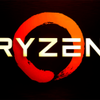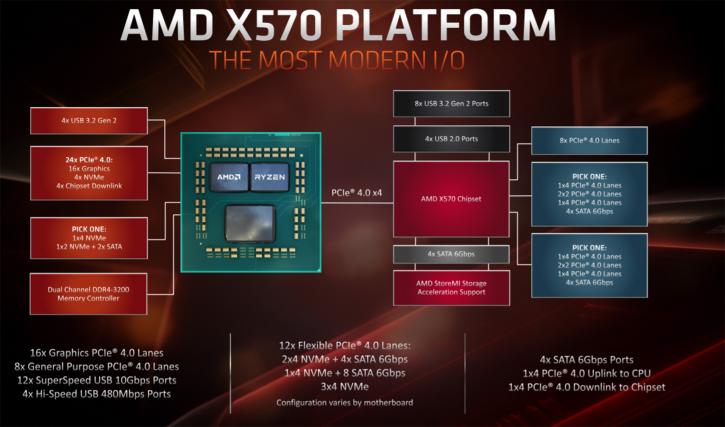PCI-Express 4.0 and the X570 Chipset
Ryzen 3000 (Matisse) delivers 24 lanes PCIe 4.0
Ryzen 3000 CPUs will have a total of 24 PCIe Gen4 lanes, yes, Gen 4.0. Four out of the twenty-four are used for the interconnect to the X570 chipset, leaving 20 lanes Gen 4.0 for other utilization. 16 lanes (PCIe x16) are intended for graphics cards that are connected as x16 or two at x8. Seen from Gen 3.0 one a Gen 4.0 x8 link would offer similar to PCIe 3.0 x16 bandwidth. Four more PCIe lanes from the CPU are designed for fast storage such as PCIe 4.0 NVMe compatible SSDs. In addition to all that, a sidenote - AMD has integrated USB 3.2 Gen2 support into the CPU, that means you get four 10 Gbps USB ports at SuperSpeed.
The X570 chipset delivers another 16 lanes PCIe 4.0
When we move to the X570 chipset, it offers 16 additional lanes of PCIe Gen 4.0, these can be re-routed and shared. Per motherboard, things are going to be connected differently. PCIe slots, M.2 SSDs, LAN, card readers or WiFi modules are to be connected via the new interface standard. The configuration depends on the respective motherboard.
Unlike the X370 and X470, the AMD X570 chipset was designed by AMD themselves and here's an interesting fact, the I/O chip that is mounted on the Ryzen 3000 processors and the AMD X570 chipset are in fact the same chips, CPUs make use of the Global Foundries 12nm version and the X570 chipset variant is the same thing, just fabricated on a 14nm process. Since the processor actually has that 12nm IO chip, which is the same as the X570 chipset, it will also offer 4x USB 3.2 Gen 2 (Superspeed 10 Gbps) ports.
| PCIe Version | Line Code | Transfer Rate | x1 Bandwidth | x4 | x8 | x16 |
|---|---|---|---|---|---|---|
| 1.0 | 8b/10b | 2.5 GT/s | 250 MB/s | 1 GB/s | 2 GB/s | 4 GB/s |
| 2.0 | 8b/10b | 5 GT/s | 500 MB/s | 2 GB/s | 4 GB/s | 8 GB/s |
| 3.0 | 128b/130b | 8 GT/s | 984.6 MB/s | 3.938 GB/s | 7.877 GB/s | 15.754 GB/s |
| 4.0 | 128b/130b | 16 GT/s | 1.969 GB/s | 7.877 GB/s | 15.754 GB/s | 31.508 GB/s |
X570 PCH actually includes sixteen PCIe lanes, in addition to the 24 PCIe lanes on the CPU, with a total of 4 (four) 4-lane physical interfaces (4x PCIe 4.0 x4 PHY), fully configurable in PCIe x16, x8, x4, x2, x1, and SATA modes. The X570 chipset offers 8x USB 3.2 Gen 2, 4x USB 2.0, 4x SATA and 8 separate PCI-Express 4.0 lanes. That leaves eight flexible lanes that can be used for PCI-Express and SATA. As you can see, the flexible design allows motherboard manufacturers lots of options in what they want to offer. When you think about it, an AMD X570 motherboard could even get four M.2 slots for PCI-Express 4.0 x4 SSDs. Please do keep in mind that only Ryzen 3000 (Zen2) will open up X570 to the CPU at PCIe 4.0 x4. If a Ryzen 3000 family proc is used or, say, an APU based on older architecture, the chipset connection will become PCIe 3.0. In the end, the X570 platform will be AMD's most advanced offering ever. It is leading over what Intel offers. The downside of all this new technology is that the motherboards are more complicated and expensive to fabricate. Expect starting prices hovering at 200 USD.
If you do not care about PCI-Express 4.0 and the connectivity that comes along with it, an X370/X470 motherboard with a firmware update will offer you the exact same performance processor and memory wise at a lower price tag.



